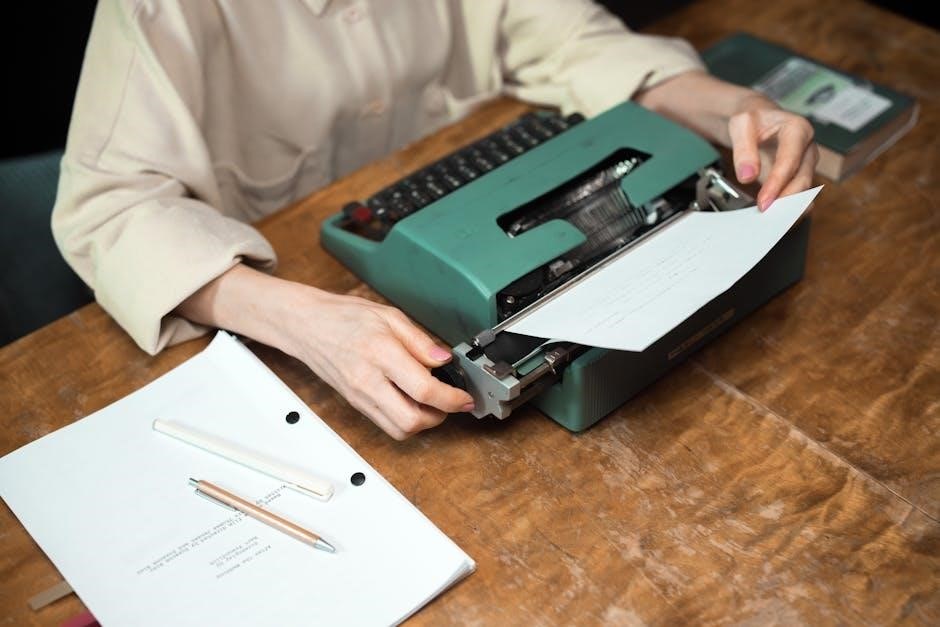The Honeywell TH5220D1003 is a non-programmable digital thermostat from the FocusPRO series, designed for single-stage and multi-stage heating and cooling systems. It offers precise temperature control, an intuitive interface, and features like Auto Changeover for efficient operation. The manual is essential for proper installation, configuration, and troubleshooting, ensuring optimal performance and energy efficiency.
1.1 Overview of the Honeywell FocusPRO Series
The Honeywell FocusPRO series is a line of non-programmable digital thermostats designed for simplicity and reliability. The TH5220D1003 model is part of this series, offering precise temperature control for single-stage and multi-stage heating and cooling systems. These thermostats are known for their intuitive interface and compatibility with various HVAC systems, including 24 VAC and 750 mV heating systems. The FocusPRO series is ideal for homeowners seeking a straightforward, energy-efficient solution without the complexity of programmable models. Its user-friendly design ensures easy operation and reliable performance, making it a popular choice for both residential and light commercial applications.
1.2 Key Features of the TH5220D1003 Model
The Honeywell TH5220D1003 features a non-programmable digital interface, offering precise temperature control with a backlit display for easy readability. It supports single-stage and multi-stage heating and cooling systems, including 24 VAC and 750 mV systems. The thermostat includes an Auto Changeover feature, which automatically switches between heating and cooling based on the set temperature. It also allows for adjustable temperature ranges and differentials, ensuring efficient energy use. With its compact design and straightforward installation process, the TH5220D1003 is a reliable and user-friendly solution for managing home comfort effectively.
1.3 Importance of the Manual for Installation and Operation
The manual for the Honeywell TH5220D1003 is crucial for ensuring proper installation, configuration, and operation. It provides detailed instructions for wiring, system setup, and troubleshooting, helping users avoid common mistakes. The manual also explains advanced features like Auto Changeover and temperature differential settings, ensuring optimal performance. By following the guide, users can maximize energy efficiency, understand error codes, and maintain their system effectively. It serves as a comprehensive reference, making it indispensable for both installation and long-term use of the thermostat.
System Compatibility and Requirements
The Honeywell TH5220D1003 is compatible with 24 VAC single-stage and multi-stage heating and cooling systems, as well as 750 mV heating systems, supporting up to 2 heat/2 cool stages.
2.1 Compatible Heating and Cooling Systems

The Honeywell TH5220D1003 is compatible with 24 VAC single-stage and multi-stage heating and cooling systems, including gas unit heaters (HD/HDB, HDS/HDC, PTS/BTS, PTC, PDP/BDP) and duct furnaces (D, H, I, & O series). It also supports 750 mV heating systems, making it versatile for various installations. The thermostat can handle up to 2 heat and 2 cool stages, ensuring flexibility for different system configurations. Proper installation requires adherence to the manual’s wiring and setup guidelines to ensure safe and efficient operation.
2.2 Voltage and Power Requirements
The Honeywell TH5220D1003 operates on 24 VAC power and is compatible with systems requiring 750 mV. It does not require a common wire (C-wire) for operation, making it suitable for installations where this is not available. The thermostat is designed to work with single-stage and multi-stage heating and cooling systems, ensuring compatibility with a wide range of setups. Proper voltage and power supply are crucial for reliable performance, and the manual provides detailed specifications to ensure safe and efficient installation.
2.3 System Types Supported (Heat/Cool Stages)
The Honeywell TH5220D1003 supports up to 2 heat and 2 cool stages, making it compatible with single-stage and multi-stage heating and cooling systems. It works with 24 VAC systems and 750 mV heating systems, providing flexibility for various configurations. The thermostat is designed to handle both single-stage and multi-stage setups, ensuring precise control over temperature. This versatility allows it to adapt to different system requirements, offering reliable performance for both heating and cooling needs. Proper system type configuration is essential for optimal operation, as outlined in the manual.

Installation Process

The Honeywell TH5220D1003 installation process is straightforward but requires careful steps. Use the manual for guidance on wallplate installation, wiring, and mounting to ensure safe and efficient setup.
3.1 Pre-Installation Checklist
Before installing the Honeywell TH5220D1003, ensure compatibility with your HVAC system and verify voltage requirements. Gather necessary tools and materials, including wires and screws. Turn off power to the system at the circuit breaker. Remove the old thermostat and label wires for reference. Ensure the wallplate is compatible and prepare the area for installation. Refer to the manual for specific system type requirements and safety precautions. Proper preparation ensures a smooth and safe installation process, avoiding potential errors or damage to the system.
3.2 Removing the Old Thermostat
Switch off the power to the HVAC system at the circuit breaker before starting. Gently pull the old thermostat away from the wall to access the wires. Carefully disconnect the wires from their terminals, taking note of their colors and positions for reference. Remove any screws or clips holding the thermostat in place. Once free, set the old thermostat aside. Ensure no wires are damaged or tangled during removal. Label the wires if necessary to simplify the installation of the new Honeywell TH5220D1003 thermostat. This step ensures a clean and safe transition to the new device.
3;3 Installing the Wallplate
Begin by removing the wallplate from the Honeywell TH5220D1003 thermostat. Align it with the mounting holes on the wall, ensuring it is level. Mark the screw holes with a pencil and drill pilot holes if necessary. Secure the wallplate using the provided screws, tightening firmly but avoiding overtightening. Ensure the surface is clean and dry before installation. Once installed, the wallplate should be flush against the wall and level for proper thermostat mounting. This step provides a stable base for the thermostat, ensuring accurate temperature sensing and smooth operation.
3.4 Wiring the Thermostat
Wiring the Honeywell TH5220D1003 thermostat requires careful attention to ensure proper system operation. The thermostat is compatible with 24 VAC heating and cooling systems, including heat-only, cool-only, and heat pump configurations. Begin by turning off the power to the HVAC system at the circuit breaker. Identify and label the wires from the old thermostat, then connect them to the corresponding terminals on the new wallplate. Refer to the manual for specific terminal designations (e.g., R, W, Y, G, C). For 750 mV heating systems, additional wiring steps may apply. Always double-check connections before restoring power.

3.5 Mounting the Thermostat
Mounting the Honeywell TH5220D1003 thermostat involves securing it to the wall after installing the wallplate. Remove the wallplate from the thermostat and attach it to the backplate, ensuring it is level. Use the provided screws to secure the backplate firmly to the wall. Once the backplate is in place, align the thermostat with the wallplate and gently snap it into position. Ensure the thermostat is mounted at a standard height for accurate temperature sensing and easy access. Refer to the manual for specific torque values to avoid over-tightening, which could damage the device.

3.6 Final Installation Checks
After completing the installation, perform a series of final checks to ensure everything functions correctly. Verify that all wiring connections are secure and match the system requirements. Check that the thermostat is properly mounted and level on the wall. Test the heating and cooling systems to confirm they turn on and off as expected. Ensure the system type and settings are correctly configured in the thermostat. Review the manual for any additional checks specific to your system. Proper installation is crucial for optimal performance and energy efficiency.
Configuration and Setup
Configure the Honeywell TH5220D1003 by setting the system type, heat, and cool settings. Adjust temperature range and differential for optimal performance. Use the manual for guidance.
4;1 Setting Up the System Type
Setting up the system type on the Honeywell TH5220D1003 ensures proper operation with your heating and cooling system. The thermostat supports single-stage and multi-stage systems, up to 2 heat and 2 cool stages. Refer to the manual to select the correct system type during configuration. This step is crucial for accurate temperature control and efficient energy use. Ensure the settings match your HVAC system’s specifications for optimal performance. If unsure, consult the manual or a professional for guidance.
4.2 Configuring Heat and Cool Settings
Configuring heat and cool settings on the Honeywell TH5220D1003 allows you to customize your comfort preferences. Set your desired temperature ranges for heating and cooling modes. The thermostat enables adjustments to temperature differential and range to optimize performance. Ensure heat and cool settings are at least 3 degrees apart to prevent short cycling. Use the manual to guide you through these adjustments, ensuring your system operates efficiently and maintains consistent comfort levels. Proper configuration enhances energy savings and system reliability.
4.3 Adjusting Temperature Range and Differential
Adjusting the temperature range and differential on the Honeywell TH5220D1003 thermostat allows for precise control over heating and cooling cycles. The temperature range sets the span between the desired temperature and the system’s activation point, while the differential determines how much the temperature can fluctuate before the system responds. Properly setting these values ensures efficient operation and prevents frequent cycling. Refer to the manual for step-by-step guidance on adjusting these settings to optimize comfort and energy efficiency. This feature is crucial for maintaining consistent indoor conditions while minimizing energy usage.

4.4 Understanding Auto Changeover Feature
The Auto Changeover feature on the Honeywell TH5220D1003 thermostat automatically switches between heating and cooling modes based on the indoor temperature. This feature is ideal for climates where both heating and cooling are needed throughout the day. To use Auto Changeover, ensure the heat and cool settings are at least 3 degrees apart. The thermostat will then select the appropriate mode to maintain the set temperature, optimizing comfort and energy efficiency. This feature reduces the need for manual mode changes, making it a convenient option for users seeking hassle-free temperature control.

Operating the Thermostat
The Honeywell TH5220D1003 operates with a user-friendly interface, allowing easy temperature adjustments, mode changes, and utilization of features like Auto Changeover for efficient comfort control.
5.1 Basic Operation and Navigation
The Honeywell TH5220D1003 features a straightforward digital interface for easy operation. Users can navigate using the buttons to adjust temperature settings, switch modes, and access menu options. The display clearly shows current temperature, setpoint, and system status. Basic functions include raising or lowering the temperature, switching between heat and cool modes, and enabling the Auto Changeover feature. The interface is designed for simplicity, ensuring users can perform essential operations without complexity. Refer to the manual for detailed instructions on navigating advanced settings and customizing your comfort experience.
5.2 Switching Between Heat and Cool Modes
To switch between heat and cool modes on the Honeywell TH5220D1003, press the “Mode” button until the desired option appears on the display. The thermostat will show icons or text indicating the current mode, such as “Heat” or “Cool.” Ensure the system is compatible with the selected mode and that temperature settings are appropriately adjusted. The thermostat requires a minimum 3-degree difference between heat and cool setpoints when using Auto Changeover. Always refer to the manual for specific instructions tailored to your system configuration and operating preferences.
5.3 Using the Auto Mode Effectively
The Auto Mode on the Honeywell TH5220D1003 allows the thermostat to automatically switch between heating and cooling based on the indoor temperature. To use this feature effectively, ensure the heat and cool setpoints are at least 3 degrees apart. Press the “Mode” button until “Auto” appears on the display. This mode is ideal for climates where both heating and cooling are needed throughout the day. The thermostat will seamlessly transition between modes to maintain your desired temperature, optimizing comfort and energy efficiency. Regularly review and adjust your setpoints to ensure optimal performance.
5.4 Energy-Saving Tips
To maximize energy savings with the Honeywell TH5220D1003, adjust the temperature settings when the space is unoccupied or during sleep hours. Lower the heat by 8-10 degrees in winter and raise the cool temperature by 4-6 degrees in summer. Use the “Hold” feature to lock in energy-saving temperatures temporarily. Regularly maintain a consistent temperature to avoid frequent adjustments, which can increase energy use. Utilize the Auto Mode effectively to let the thermostat manage heating and cooling transitions, optimizing efficiency and reducing utility bills.

Troubleshooting Common Issues
Address display issues, temperature inaccuracies, or system malfunctions by checking wiring connections and power supply. Consult the manual for error code interpretations and reset instructions if needed.
6.1 Display Issues and Error Codes
Display issues on the Honeywell TH5220D1003 may include a blank screen or faulty readings. Check power supply and wiring connections first. Error codes like “E1” or “E2” indicate specific problems, such as temperature sensor malfunctions or system communication issues. Refer to the manual for code interpretations. Resetting the thermostat by removing batteries or power can often resolve temporary glitches. If issues persist, ensure proper installation and consult troubleshooting guides. Addressing these problems promptly ensures accurate temperature control and system efficiency.
6.2 Temperature Inaccuracy Problems
Temperature inaccuracy issues with the Honeywell TH5220D1003 can arise from incorrect placement, sensor malfunctions, or calibration errors. Ensure the thermostat is not exposed to drafts or direct sunlight. Check the temperature sensor for damage or dirt. If the display shows incorrect readings, recalibrate the thermostat by following the manual’s instructions. Verify wiring connections to ensure proper communication between components. If issues persist, reset the thermostat or consult the troubleshooting section of the manual for detailed guidance. Accurate temperature control is crucial for system performance and energy efficiency.
6.3 System Not Turning On or Off
If the system fails to turn on or off, check the power supply and ensure the thermostat is properly wired. Verify that the system type (heat/cool) is correctly configured in the settings. Loose connections or incorrect wiring can prevent the system from functioning. Consult the manual to ensure all wiring matches your system type. If the issue persists, reset the thermostat by removing the batteries or switching off the power. Refer to the troubleshooting section of the manual for detailed steps to resolve this issue and restore normal operation.
6.4 Interpreting and Solving Error Codes
Understanding error codes is crucial for effective troubleshooting. The Honeywell TH5220D1003 manual lists common error codes like E1, E2, and E3, which indicate issues such as temperature differences, sensor problems, or system communication failures. For example, E1 may signify a large temperature differential, while E3 could point to a sensor malfunction. Refer to the manual for specific code meanings and solutions. Often, resolving these issues involves checking wiring connections, cleaning the sensor, or resetting the thermostat. If errors persist, consult the troubleshooting guide or contact Honeywell support for further assistance.
6.5 When to Reset the Thermostat
Resetting the Honeywell TH5220D1003 thermostat is necessary in specific situations, such as after addressing error codes, replacing batteries, or resolving power issues. To reset, remove the batteries and press the reset button located on the back of the thermostat. Hold for 5 seconds, then reinstall the batteries. This process clears temporary glitches and restores default settings. Resetting is also recommended if the thermostat becomes unresponsive or displays incorrect information. Always refer to the manual for detailed reset instructions to ensure proper functionality and avoid potential system issues.

Maintenance and Care
Regular maintenance ensures optimal performance. Clean the thermostat with a soft cloth, replace batteries annually, and update software for the latest features and fixes.
7.1 Cleaning the Thermostat
Cleaning the Honeywell TH5220D1003 thermostat is essential for maintaining its performance and accuracy. Turn off the power to the thermostat at the circuit breaker before cleaning. Use a soft, dry cloth to gently wipe the display and exterior surfaces, removing dust or debris. Avoid using harsh chemicals, abrasive cleaners, or wet cloths, as they may damage the thermostat. For stubborn stains, lightly dampen the cloth with water, but ensure no moisture enters the vents or openings. Regular cleaning prevents dust buildup, ensuring reliable temperature sensing and smooth operation. Refer to the manual for detailed cleaning instructions.
7.2 Replacing Batteries
To replace the batteries in your Honeywell TH5220D1003 thermostat, first ensure the system is powered off at the circuit breaker. Locate the battery compartment, usually found on the front or side of the thermostat. Open the compartment and remove the old batteries. Install new AAA alkaline batteries, ensuring correct polarity. Close the compartment and turn the power back on. The thermostat should now function properly. If the display remains dim or unresponsive, check the battery connections or try replacing the batteries again. Refer to the manual for specific instructions and recommendations.
7.3 Updating Software or Firmware
Updating the software or firmware of your Honeywell TH5220D1003 thermostat ensures optimal performance and security. Check the Honeywell website for the latest updates compatible with your model. Download the update file and follow the manual’s instructions for installation. Ensure the thermostat is powered on and connected to a stable power supply during the update process. If issues arise, refer to the troubleshooting section of the manual or contact Honeywell support for assistance. Regular updates help maintain functionality and improve user experience.
Additional Resources
Access the full manual, online guides, and tutorials for detailed instructions. Join community forums for user support and tips. Contact Honeywell directly for professional assistance.
8.1 Accessing the Full Manual
The full manual for the Honeywell TH5220D1003 is available for download as a free PDF from Honeywell’s official website or authorized distributors. It provides comprehensive instructions for installation, configuration, and troubleshooting. The manual includes detailed wiring diagrams, system setup guidelines, and error code interpretations. Users can also find operational tips and maintenance recommendations. Additionally, the manual covers advanced features like Auto Changeover and temperature differential settings. Ensure to download the correct version (TH5220D1003) for accurate information tailored to your thermostat model. Referencing the manual is crucial for optimal performance and safe operation of the device.
8.2 Online Guides and Tutorials
Honeywell offers various online guides and tutorials to help users master the TH5220D1003 thermostat. These resources are available on Honeywell’s official website and include step-by-step installation videos, configuration tips, and troubleshooting walkthroughs. Additionally, third-party platforms provide interactive tutorials and community forums where users can share experiences and solutions. These guides cover topics like wiring, system setup, and advanced features, ensuring users can optimize their thermostat’s performance. They are free to access and designed to complement the manual, offering visual and practical insights for a smoother learning curve.
8.3 Community Support and Forums
Honeywell’s community support and forums provide a platform for users to connect, share experiences, and resolve issues related to the TH5220D1003 thermostat. These online spaces are filled with discussions, tips, and solutions from experienced users and technicians. Members often post troubleshooting advice, installation insights, and optimization techniques. The community is a valuable resource for understanding advanced features and addressing specific challenges. By engaging with these forums, users can gain practical knowledge and confidence in operating their thermostat effectively. This collective support enhances the overall user experience and fosters a sense of collaboration among Honeywell product enthusiasts.
8.4 Contacting Honeywell Support
For direct assistance with the Honeywell TH5220D1003 thermostat, users can contact Honeywell Support through various channels. The official website provides contact information, including phone numbers, email, and live chat options. Support representatives are available to address installation, configuration, and operational issues. Additionally, the manual directs users to Honeywell’s customer service for troubleshooting and advanced technical support. Reaching out to Honeywell Support ensures personalized solutions and expert guidance, helping users maximize their thermostat’s performance and resolve any challenges efficiently.
The Honeywell TH5220D1003 thermostat offers efficient temperature control and ease of use, ensuring optimal performance. Refer to the manual for detailed installation, configuration, and troubleshooting guidance.
9.1 Summary of Key Points
The Honeywell TH5220D1003 is a non-programmable digital thermostat designed for single-stage and multi-stage heating and cooling systems. It offers precise temperature control, an intuitive interface, and features like Auto Changeover for efficient operation. The manual provides essential guidance for installation, configuration, and troubleshooting, ensuring optimal performance. Key features include compatibility with various system types, energy-saving capabilities, and a user-friendly design. Proper installation and setup are crucial for maximizing efficiency and comfort. Refer to the manual for detailed instructions and troubleshooting tips to maintain optimal functionality and energy efficiency.
9.2 Final Tips for Optimal Performance
For optimal performance, regularly clean the thermostat and ensure proper battery maintenance. Adjust temperature settings when away to save energy. Use the Auto Changeover feature wisely for climates requiring both heating and cooling. Refer to the manual for troubleshooting common issues and updating firmware. Ensure all wiring connections are secure during installation. Set clear temperature ranges and differentials for consistent comfort. Familiarize yourself with error codes to address issues promptly. By following these tips, you can maximize efficiency, comfort, and the lifespan of your Honeywell TH5220D1003 thermostat.
